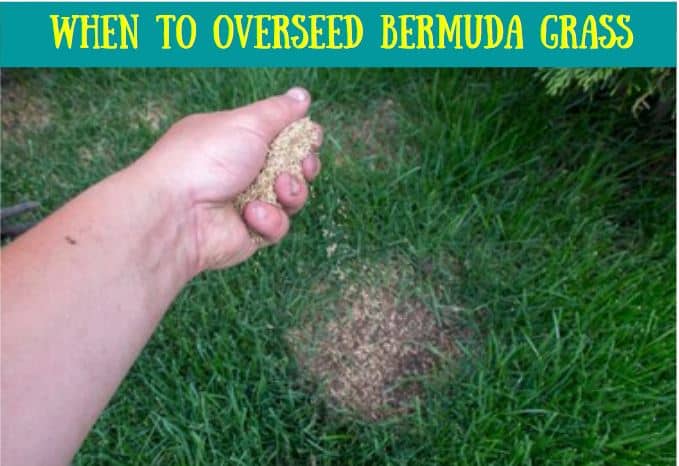When you realize that your once-beautiful Bermuda grass lawn is thinning out in certain areas, you’ll want to consider overseeding to fill in the bare spots.
If you’re wondering when to overseed Bermuda grass, it’s in the spring because it’s the best period for optimum growth of grass seed due to the favorable soil temperature.
Read the following comprehensive guide on when and how to overseed your Bermuda grass turf as well as the types of grasses to overseed with.
When to Overseed a Bermuda Grass Lawn

Given it’s a warm-season grass variety, the best time of the year to overseed your Bermuda grass lawn is from spring to early summer. This time of the year is usually the peak growth season for Bermuda grass and other warm-season grass species.
In spring soil temperatures are usually warm enough to facilitate Bermuda seed development. The absence of freeze and frost at this time of the year means that seed germination is unlikely to be hampered when planted. Frosty conditions can kill Bermuda seeds.
The other reason why you should plant Bermuda seeds during the peak growth season (spring-summer) is that planting before or after this time window can slow down the germination rate.
For example, Bermuda grass seeds planted in mid-spring under perfect conditions will take less than a full week to germinate. What’s more, a Bermuda grass lawn established by seeding can develop and be ready for use in about one-and-a-half months.
However- when planted under unsuitable conditions (say, early fall) – Bermuda seeds may take up to three weeks to germinate and even longer than that to be fully developed (8-10 weeks).
Finally, don’t overseed a new Bermuda lawn unless it’s been established for at least 90 days. This is the minimum duration required for Bermuda grass underground shoots (rhizomes) to fully mature. Read this to decide if overseeding is right for you.
How to Overseed Bermuda Grass
To plant new grass seedlings on an existing Bermuda lawn, you first need to prepare the lawn area by coring. This should be done some weeks before overseeding. After prepping the lawn, you can then broadcast the seeds in multiple directions using a rotary spreader.
You can set the spreader to release just a few seeds at a time, as you move through the lawn. This allows for a uniform spread, which is especially important if you’re overseeding your Bermuda lawn with a ryegrass variety since ryegrass lacks lateral shoots to facilitate spreading into bare spots on your lawn.
If you’re overseeding a lawn area that tends to experience heavy foot traffic, it’s advisable to incorporate a sand mix topdressing to accelerate turf establishment for the newly planted seeds. After that, you can drag the seeds to the soil level using a rake.
Grass Mix: What Grass Seed to Overseed With
You can overseed your lawn with a similar Bermuda grass seed if you want to keep things uniform. However, for a dense, green Bermuda lawn all year round, you might want to consider a grass mix to help complement the shortcomings of this grass variety.
But what grass seed can you overseed Bermuda grass with? Here are the grass options to consider:
Annual and perennial ryegrass
Since Bermuda is a warm-season grass variety, you can avoid having to live with a landscaping eyesore during winter by overseeding your Bermuda lawn with cool-season grass species, including annual ryegrass and perennial ryegrass.
While annual ryegrass seeds are cheaper, this species has poor heat resistance and dies out by mid-summer. Perennial ryegrass seed, on the other hand, is fairly expensive but will stay green all year round unless summer heat conditions become too extreme.
Perennial ryegrass also has an aesthetical advantage over annual ryegrass, in that its finer leaf structure is regarded as more beautiful to look at, compared to its tall-growing sister species.
However, if you’re looking to overseed your Bermuda lawn with a species that will grow quickly and have your lawn looking great within just a few weeks, go for the annual ryegrass which establishes faster.
I like the Turf Star Ryegrass seed because it offers a deep green look and is popular to use on golf courses, so why not have that look at home over the winter :). Check it out here.
As a side note, once the cold season is over and the ryegrass that was seeded over Bermuda is no longer needed, you can now eliminate the ryegrass to prevent it from competing for nutrients with the desirable Bermuda plants.
This should be done as summer approaches, as this is the season when there’s an increased rate of new Bermuda growth. Eliminating the ryegrass can be done using a herbicide.
Fescue
Ryegrass aside, you can also overseed Bermuda grass turfs with Fescue grass varieties. Being a cool-season grass, fescue maintains its lush green color in all seasons except summer.
By then, warm-season Bermuda usually has grown back, thereby allowing homeowners with this turf mix to maintain green lawns all year round. I have used the Highlander II Fescue seed with good results on lawns in the past and will continue to use it. Learn more about Highlander II Fescue seed here.
Mowing and Lawn Care after Overseeding
We recommend mowing your Bermuda lawn about a month after overseeding. However, if the rate of growth is too fast, you may need to mow after a fortnight.
After the initial mowing, you can schedule subsequent mowing sessions every three days. See this link for my guide on the correct mowing height and schedule for Bermudagrass lawns.
- The standard mowing height for Bermuda grass is about half an inch.
- Mowing any lower requires you to increase the frequency of mowing, as well as adopt a more detailed maintenance routine in terms of fertilization and watering.
- Still, there exist hybrid Bermuda grass varieties that can be mowed at low heights of about one inch and still maintain their beautiful appearance.
Fertilization should be avoided for the initial three weeks post-overseeding. This is because the fertilizer will accelerate the growth rate of the pre-existing Bermuda grass plants on the lawn, causing them to grow tall and shade the newly planted seedlings. The shade prevents the seedlings from receiving adequate sunlight, which is crucial for root development and growth support.
The proper time to begin fertilization for a recently overseeded Bermuda lawn, therefore, is when the roots of the new seedlings are fully established. Typically, this is about three to four weeks after overseeding. Follow this bermudagrass schedule thereafter.
Hi, Alex Kuritz here. Growing up I remember that my family had one of the best lawns in the neighborhood. Richly green and lush. I did a lot as I grew up in terms of caring and tending for not only my family’s lawn but also my neighbors. I can say I have years of experience, and I am here to share it with you.





In September you are gonna aerate your yard and over seed. Meaning your gonna take a machine that take cores out of your lawn and then your gonna overseed if you have tall fescue that means 10lbs per 1000 sqft if you have Bermuda that’s 5 lbs per sqft.
If you have a warm season grass you’re gonna put down a cool season grass for the winter that way the lawn is green all year long. If your yard is Bermuda or any other warm season turf you will most likely put a Ryegrass seed out when over seeding. If cool season lawn put out a cool season turf seed.
Hi,
I live in San Antonio, TX 78254 area code.
We have some sort of hybrid tiff grass.
It is ok-ish but I want Bermuda grass. I want the thick blades that grow up and not the tiny blades that seem to never grow. What type of bermuda grass is this and do you have pics? Pl, ty in advance.
Lynn
Hello,
I just had Bermuda laid, I put top soil and fertilizer on before it was laid.. When do I add Bermuda seeds to get the rich green full look?
if you have good Bermuda sod then you shouldn’t need to seed it as the Bermuda will spread and get thick on its own.
Correction Bermuda sod laid